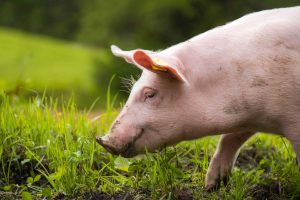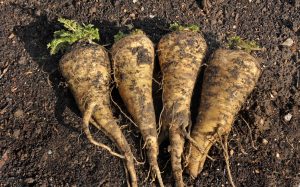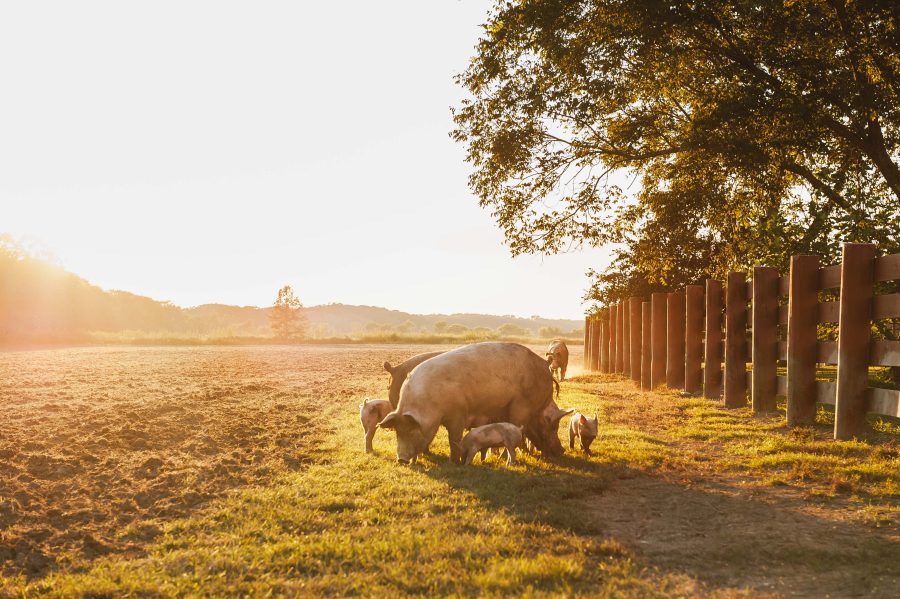Michaela Giles explains which plants can be harmful to your pigs, and how to recognise the signs when trouble strikes.
The two most common poisonings caused by plants that are reported by the Animal and Plant Health Agency (APHA) and The National Animal Disease Information Service (NADIS) are bracken and hemlock. So it makes sense to check for both of these in any paddocks, and know the tell-tale, clinical signs to look out for.
But these aren’t the only two to watch out for. Pigs can be poisoned by a number of different plants, and their derivatives (refer to table 1.0). As you might imagine, trouble is most likely to strike among pigs that are kept outdoors, and can affect the animals being kept by smallholders and those operating on a larger, commercial scale, where the pigs have access to woodland and natural water sources, as well as non-commercially managed pasture.
Beware of bracken
The rhizomes (horizontal, underground plant stems capable of producing the shoot and root systems of a new plant) and young leaves contain the enzyme Thiaminase, in a greater quantity than the adult leaves do. If ingested, this has the effect breaking-down Thiamine (vitamin B1) in the body, causing a deficiency in around six weeks of constant exposure.
Exposure to the young plants and rhizomes is via the pigs rooting behaviour. Access to growing bracken is a predisposition to ingestion and its toxic effects. It should be noted that poisoning can also occur if bracken gets incorporated into pig bedding.

Bracken-poisoning is reportable to the Food Standards Agency as a potential food safety incident, and pigs must be withdrawn from potential exposure to bracken for at least 15 days prior to slaughter for human consumption of meat and offal. The clinical signs of bracken poisoning are listed in the table below.
At post-mortem, a differential diagnosis (possible alternative diagnosis) for the gross lesions include mulberry heart disease, Porcine Corona Virus 2, fumonisin (mycotoxin/mould) toxicity, encephalomyocarditis virus and other causes of heart failure, such as the congenital defect, endocarditis. Knowing the pigs have been exposed to bracken will assist in confirming the diagnosis.
The Animal and Plant Health Agency (APHA) Pig Expert Group has produced a comprehensive guide to bracken poisoning in pigs, should you require further information, details of which are included at the end of this article.
Harmful hemlock
This plant contains eight different toxic compounds; the two major ones are coniine which is in the seed, and gamma-coniceine, which is found predominantly in the green, vegetative growth. Both of these toxic substances cause paralysis of the muscles, by acting as a neuromuscular blocking agent, and can do so even in small doses.
The potency of these compounds found in hemlock varies, and is dependent upon the species of plant, its stage of growth, the season, moisture and temperature levels, the time of day and geographical region.
The two, major toxic effects seen after ingestion in pigs, can be acute or sub-acute. Acute is rapid, with often fatal effects on the nervous system, while sub-acute causes congenital abnormalities if eaten in the first trimester of pregnancy. These substances continuously reduce foetal movement during tissue formation, resulting in crooked legs, deformed necks and spines. Occasional cleft palates may be seen due to the lack of foetal movement in the head and neck regions, preventing normal palate closure during embryo development.
Hemlock species grow along roadsides, along the base of fences and in pastures and hay fields. Some species even thrive around waterways. If hemlock is found dried in hay, the effects are reduced, but the plant will still retain some toxicity. Also, seeds are a highly toxic source of poisoning if they’re able to contaminate grain. With this in mind, it’s always advisable to buy hay and feed from a reputable supplier, if you don’t make your own. The clinical signs to be watched for are listed in the table below.
No specific treatment for poisoning exists, however, the ‘good’ news is that if an acute poisoning does not advance to respiratory failure and death, the prognosis for a full recovery is good.

Feeding parsnips – or turning pigs out where parsnips were the last crop grown – can cause contact photosensitisation
Umbellifera plants
These plants are related to the hemlock species and include some familiar herbs and vegetables including parsnips, parsley, carrot, celery, fennel, dill, coriander, caraway and cumin. It is known that some of these can cause toxic effects when fed to pigs, the most documented of which is parsnips. The top leaves of Umbellifera plants particularly contain toxic substances.
Feeding parsnips – or turning pigs out where parsnips were the last crop grown – can cause contact photosensitisation. This is an enhancement of the skin’s sensitivity to the UV rays in direct sunlight, and outbreaks of red, inflamed skin lesions/blisters, especially around the mouth and ventral areas, will be caused.
In the UK, further consequences of exposing pigs to parsnips have been reported. An outdoor producer suffered dire consequences from putting pigs into a field that had grown parsnips. The crop had been incorporated rather than lifted and parsnips are poisonous. It resulted in four sows going blind and being put down, and left many more in pain, screeching and behaving oddly. The producer is sure that most of the sows will have aborted.
NOTE: Parsnips are not the only toxic substance you need to be mindful of if your pigs are following a crop rotation, some fertilisers are also toxic.
There’s also the possibility of the discovery of new toxic plants when the situation lends itself and so if your pigs have been turned out in a new pasture or previously un-rooted woodland, it is worth identifying if there are any potentially toxic plants present.
Case history: New toxic plants being discovered
The introduction of free-range pigs on to uncultivated agricultural land has resulted in a new syndrome being identified recently.
A smallholder in North-East Victoria, in Australia, had 12, free-range pigs that became blind and started trembling. Many were sitting ‘like a dog’ while others walked with a stilted gait. Some had urinary incontinence and dribbled constantly, and, for the majority, death ensued. The investigation into the possible causes (differentials) into this unknown cause included possibilities such as bacteria, viruses, nutritional issues and toxins.
The post-mortem histopathological examination showed an advanced degeneration of the nerves in the white matter of the brain and spinal cord. A disease with a similar presentation had previously been reported in cattle that were known to have eaten Stypandra grass, which contains the toxin Stypandrol. This resulted in a condition that’s colloquially known as Blind Grass poisoning.
But, as Stypandra grass wasn’t local to the area where the pigs were being kept, other plants were investigated. Out of 30 species of trees, shrubs and plants identified in or near the pigs, Blue Berry flax (Dianella reflexa) was quickly identified the possible culprit. This plant is also known to contain the toxin stypandrol in the underground rhizomes, which had been uprooted and eaten by the pigs.
There are other plants that haven’t been reported as toxic to pigs globally, or reported locally in isolated incidents. So, if you’re seeing common signs of poisoning, or unusual clinical signs, then take a good look around the paddock and bear plant poisoning in mind.
Clinical signs of bracken poisoning
- Acute heart failure
- Difficulty breathing
- Occasionally lack of co-ordination
- High number found dead with no clinical signs observed
- Lung oedema (accumulation of fluid)
- Body cavity effusions (liquid, gas)
Clinical signs of hemlock poisoning
- Nervousness, trembling, muscle weakness, poor co-ordination
- Excess salivation (slobbering)
- Initial stimulation or excitement followed by depression
- Dilation of the pupils
- Weak heartbeat
- Musty, mousy odour to breath and urine
- Congenital deformities in piglets
- Prolapse of the third eyelid across the cornea, which may cause temporary blindness
- Death by respiratory failure due to paralysis of respiratory muscles
The APHA’s comprehensive guide to bracken poisoning – click here.
Table 1.0 Some of the reported plants known to be toxic to pigs. Diagnosis is, more often than not, determined by the presence of the plant and clinical history.
| Plant | Found/causes | Clinical signs | Treatment |
| Bracken
(Pteridium sp) |
Woodland areas
Thiamine levels decrease after six weeks of constant exposure |
Respiratory distress
Death Can be detected by serology |
Thiamine injection
Prevent access
|
| Umbellifera plants | Crop fields
Photosensitisation of the skin |
Angry red lesions and blisters on exposed skin and in mouth | Remove access |
| Cocklebur
(Xanthium sp)
|
Eating two-leaf seedlings often found around waste areas, edges of water
NB: Adult plant is unpalatable |
Depression vomiting, weakness, ataxia, (incoordination), associated liver failure
Rapid breathing, convulsions, decrease in temperature Death within hours |
Oral administration of mineral or sunflower oil |
| Jimson Weed
(Datura stramonium) |
All parts of the plant – especially the seeds – contain many toxic compounds including hyoscyamine, hyoscine and atropine | Impaired vision due to pupil dilation
Excessive thirst Decreased gastrointestinal activity Increased heart rate Convulsions
|
Prevent access
Plants are usually unpalatable but seeds may be found occasionally in grain |
| Deadly Nightshade
(Atropa belladonna) |
Waste areas, hayfields especially toxic when in fruit (berries)
Rare occurrence |
Acute bloody gastroenteritis
Salivation Trembling Paralysis Coma Death |
Administration of Pilocarpine (POV) |
| Young oak leaves and green acorns
NB: some pigs are traditionally raised on mature acorns |
Found in fields and woodlands
Clinical signs seen 2-3 days after ingestion |
Abdominal pain
Constipation Kidney disease (rare) |
Prevent access |
| Pig weed
(Amaranthus retroflexus) |
Accumulation of fluid around the kidneys – can be determined using ultrasound
Oxalic acid* builds up after 2-3 days. Found in pastures during the warmer months |
Trembling
Ataxia associated with kidney failure Lie on their bellies Hind leg paralysis Clinical signs appear within 5-10 days after exposure |
Prevent access
*known Anti-nutritional Factor
|
| Red Clover
(Trifolium pratense) Aka Black Patch Disease seen on the forage |
Clover infected with a fungus (Rhizoctonia leguminocola)
When eaten releases the toxin Slaframine. Found in cool wet conditions during spring and autumn. |
Excess salivation and slobbering
Tearing in the eyes Diarrhoea Bloating Frequent urination Photosensitisation of the skin |
Prevent access |
| Sorghum or coarse grass
(Poaceae sp) |
Contains hydrocyanic acid – a solution of hydrogen cyanide | Difficulty breathing
Convulsions Bright red-to-chocolate-coloured blood associated with the formation of nitrates determined by haematology |
Intravenous injection with methylene blue (POV) |
| Yellow Jasmine
(Gelsemium sempervirens) |
Found in woodlands | Ataxia
Weakness Coma Death within 48 hours |
No treatment
Sedation to control convulsions |
| Poison hemlock (Conium maculatum),
Water hemlock (Cicuta maculata), Fool’s parsley (Aethusa cynapium) |
Ubiquitous and found in pasture, roadsides and in open, wet, moist ground
Highly toxic |
Death within 30-50 minutes
Violent muscle spasms Dilated pupils Convulsions and coma |
No treatment
Sedation to control convulsions |
| Foxglove
(Digitalis purpurea)
|
Usually found ornamentally but can be found globally. Due to the unpalatable taste, poisoning is infrequent.
|
· Drooling
· Nausea · Vomiting · Abnormal heart rate · Cardiac arrhythmias · Weakness · Collapse · Dilated pupils · Tremors · Seizures · Death |
Prevent access
An antidote is available but likely to be cost prohibitive |
| Henbane
(Hyoscyamus niger) NB: Wikipedia incorrectly says that pigs are immune to this hallucinogenic plant |
A herb causing albeit very rare cases of poisoning across the globe.
Contains the toxic compounds Hyoscyamine, hyoscine and atropine. Pigs have been reported to have died after eating the roots of the plant. |
Depression of the central nervous system
Restlessness, excitation, convulsions Pupil dilation Difficulty in breathing, increased heart rate Blueing of mucus membranes
|
Some reversal treatments are available if the cause is identified quickly
Supportive care |
| Ivy
(Hedera sp) |
Ubiquitous
While the whole of the plant is poisonous, the leaves and berries are the most toxic parts. Ivy also tastes bitter and therefore unlikely to be eaten in excess |
Contact dermatitis on the skin
Drooling Diarrhoea Vomiting If larger amounts of the plant are consumed, hyperactivity, breathing difficulties Fever Ataxia Muscular weakness, coma |
Prevent access |
| Laburnum
(Laburnum anagyroides) |
Discarded hedge clippings containing laburnum | Loss of appetite
Convulsions Death
|
Do not feed or discard hedge clippings within pigs’ access |
| Yew
(Taxus sp) European/English Yew considered one of the most toxic at around 0.1% of the animal’s body weight consumed
|
Found globally as plants, shrubs and trees.
Undigested yew found at post-mortem |
Acute Syndrome (pigs more susceptible to acute poisoning)
Death from heart attack 1-3 hours after ingestion – often found dead next to yew bushes Subacute Syndrome, ataxia, diarrhoea, hypothermia, coma, seizures, weakness, respiratory failure Death within 24 to 48 hours |
Survival without treatment is possible but occurs infrequently
No treatment for acute poisoning Aggressive decontamination of stomach using activated charcoal and magnesium sulphate |
More content like this can be found in The Country Smallholder magazine. Subscribe here.
For FREE updates from the world of smallholding, sign up for The Country Smallholder newsletter here.








